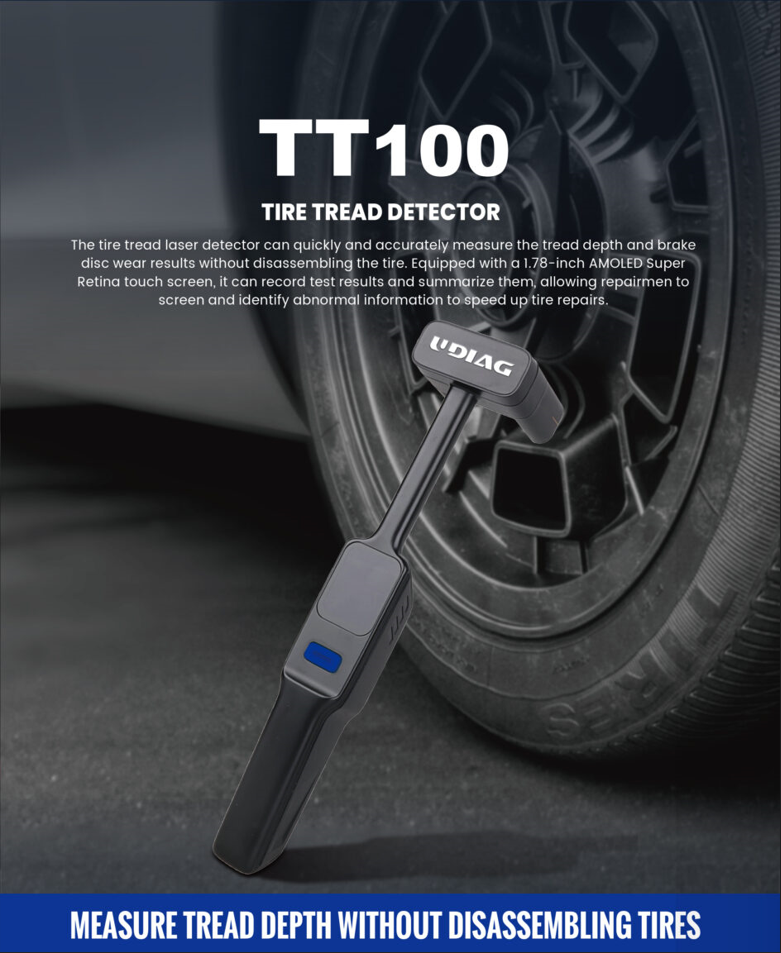What are the benefits of using tire tread detectors?
2024-05-16 by UDIAG
Tire tread detectors are tools designed to measure the depth and condition of tire tread, playing a crucial role in vehicle safety and maintenance. These devices range from simple manual gauges to advanced digital systems, and can be either handheld or integrated into the ground for automatic readings. Proper tire tread maintenance is vital for ensuring safety, complying with legal standards, and managing economic expenses related to vehicle upkeep.

I. Enhanced Safety
One of the primary benefits of using tire tread detectors is the enhancement of vehicle safety. Adequate tire tread ensures better traction and braking performance, significantly reducing the risk of accidents. Particularly in wet conditions, good tread depth is essential to prevent hydroplaning, where tires lose contact with the road surface due to water. Early detection of tread wear through regular monitoring allows drivers to address issues before they become severe. Uneven tread wear can indicate alignment problems or other mechanical issues, which, if left unchecked, could lead to tire failure and potentially dangerous situations on the road.
II. Cost Savings
Using tire tread detectors can result in substantial cost savings. Regular monitoring and timely maintenance of tires can extend their lifespan, delaying the need for replacements. By optimizing tire rotation schedules based on tread wear patterns, drivers can ensure even wear across all tires, maximizing their use. Additionally, by preventing severe tire damage and blowouts through early detection, drivers can avoid costly repairs and potential damage to the vehicle’s suspension and alignment systems. These proactive measures not only save money but also reduce the inconvenience of unexpected tire issues.
III. Environmental Benefits
Tire tread detectors contribute to environmental conservation by reducing tire waste. Prolonging the lifespan of tires decreases the frequency of tire disposal, lowering the environmental impact associated with manufacturing and discarding tires. Moreover, maintaining tires in good condition enhances fuel efficiency. Properly maintained tires offer better traction and reduce rolling resistance, leading to improved fuel economy and a lower carbon footprint. This environmental benefit is particularly significant in the context of growing concerns about climate change and resource sustainability.
IV. Legal and Regulatory Compliance
Adhering to safety standards and legal requirements is another critical benefit of using tire tread detectors. Many states and countries have specific regulations regarding minimum tread depth, and non-compliance can result in fines and penalties. For commercial fleet operators, ensuring that all vehicles meet these regulations is essential for avoiding legal issues and maintaining a good reputation. Tire tread detectors simplify inspections and documentation, making it easier to ensure that vehicles are always compliant with legal standards, thus enhancing overall fleet management efficiency.
V. Technological Advancements
Advances in technology have significantly improved the accuracy and convenience of tire tread detectors. Digital and automated tread detectors provide precise measurements and can integrate with vehicle monitoring systems to offer real-time data and alerts. These advancements make it easier for drivers and mechanics to monitor tire conditions and take timely actions. The user-friendly nature of modern detectors means that regular checks can be performed quickly and efficiently, encouraging more frequent use and better tire maintenance practices.
VI. Case Studies and Real-world Applications
Numerous case studies and real-world applications highlight the benefits of using tire tread detectors. Fleet management companies have reported significant reductions in tire-related incidents and maintenance costs by implementing regular tread monitoring. Public transportation systems, which rely heavily on tire safety, have also benefited from improved safety records and cost savings. Individual drivers have found that regular use of tire tread detectors leads to better vehicle performance and fewer unexpected tire issues, enhancing their overall driving experience.
Conclusion
In summary, the use of tire tread detectors offers a wide range of benefits, from enhanced safety and cost savings to environmental conservation and legal compliance. The technological advancements in these devices further increase their accuracy and convenience, making them an essential tool for modern vehicle maintenance. Regular use of tire tread detectors not only ensures safer driving conditions but also contributes to economic and environmental sustainability. As technology continues to evolve, the future outlook for tire maintenance looks promising, with even more efficient and user-friendly solutions on the horizon.
FAQs
Q1: What is a tire tread detector?
A tire tread detector is a device used to measure the depth and condition of the tread on a vehicle’s tires. These devices can be manual gauges, digital tools, or even automated systems integrated into the ground.
Q2: Why is maintaining proper tire tread important?
Proper tire tread is crucial for safety, as it ensures good traction and braking performance, especially in wet or slippery conditions. It also helps prevent accidents caused by hydroplaning and other tire-related issues.
Q3: How do tire tread detectors enhance vehicle safety?
Tire tread detectors help identify wear patterns and potential tire failures early, allowing drivers to address issues before they lead to accidents. Regular monitoring ensures that tires maintain optimal performance and traction.
Q4: Can using tire tread detectors save money?
Yes, regular use of tire tread detectors can save money by prolonging tire life through timely maintenance and optimized tire rotation. It also helps avoid costly repairs by preventing severe tire damage and blowouts.
Q5: Are there environmental benefits to using tire tread detectors?
Absolutely. By extending the lifespan of tires, tread detectors reduce tire waste and the environmental impact associated with manufacturing and disposing of tires. Additionally, well-maintained tires improve fuel efficiency, reducing the vehicle’s carbon footprint.
Q6: How do tire tread detectors help with legal compliance?
Many regions have regulations specifying minimum tread depth for vehicle tires. Using tread detectors ensures that tires comply with these legal standards, helping avoid fines and ensuring safety. This is particularly important for commercial fleet operators.


